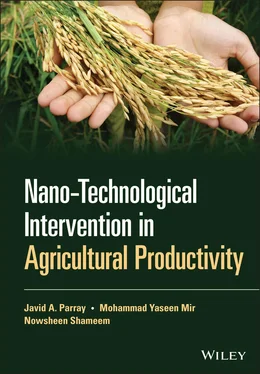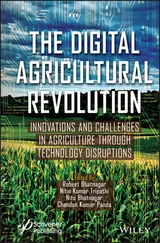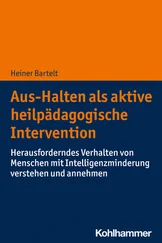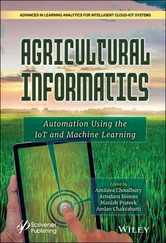41 41 Alonso, A., Macanas, J., Davies, G.L. et al. (2011). Environmentally‐safe polymer‐metal nanocomposites with most favorable distribution of catalytically active and biocide nanoparticles. In: Advances in Nanocomposite Technology (eds. A. Alonso, J. Macanás, G.‐L. Davies, et al.), 176–200. Rijeka, Croatia: Intech.
42 42 Lapied, E., Nahmani, J.Y., Moudilou, E. et al. (2011). Ecotoxicological effects of an aged TiO2 nanocomposite measured as apoptosis in the anecic earthworm Lumbricus terrestris after exposure through water, food and soil. Environ. Int. 37 (6): 1105–1110.
43 43 Muraviev, D.N., Macanas, J., Farre, M. et al. (2006). Novel routes for inter‐matrix synthesis and characterization of polymer stabilized metal nanoparticles for molecular recognition devices. Sens. Actuators, B 1181 (2): 408–417.
44 44 Savage, N. and Diallo, N. (2005). Nanomaterials and water purification: opportunities and challenges. J. Nanopart. Res. 7 (4–5): 331–342.
45 45 Adams, L.K., Lyon, D.Y., and Alvarez, P.J.J. (2006). Comparative ecotoxicity of nanoscale TiO2, SiO2, and ZnO water suspensions. Water Res. 40 (19): 3527–3532.
46 46 Lu, A.H., Salabas, E.L., and Schuth, F. (2007). Magnetic nanoparticles: synthesis, protection, functionalization, and application. Angew. Chem. Int. Ed. 46 (8): 1222–1244.
47 47 Laurent, S., Forge, D., Port, M. et al. (2008). Magnetic iron oxide nanoparticles: synthesis, stabilization, vectorization, physicochemical characterizations, and biological applications. Chem. Rev. 108 (6): 2064–2110.
48 48 Medyak, G.V., Shunkevich, A.A., Polikarpov, A.P. et al. (2001). Features of preparation and properties of FIBAN K‐4 fibrous sorbents. Russ. J. Appl. Chem. 74 (10): 1658–1663.
49 49 Grillo, R., Abhilash, P.C., and Fraceto, L.F. (2016). Nanotechnology applied to bio‐encapsulation of pesticides. J. Nanosci. Nanotechnol. 16: 1231–1234. https://doi.org/10.1166/jnn.2016.12332.
50 50 Jiang, S., Eltoukhy, A.A., Love, K.T. et al. (2013). Lipidoid‐coated iron oxide nanoparticles for efficient DNA and siRNA delivery. Nano Lett. 13: 1059–1064. https://doi.org/10.1021/nl304287a.
51 51 Mishra, S. and Singh, H.B. (2016). Preparation of biomediated metal nanoparticles. Indian Patent Filed 201, 611, 003, 248.
52 52 De La Torre‐Roche, R., Hawthorne, J., Deng, Y. et al. (2013). Multiwalled carbon nanotubes and C60 fullerenes differentially impact the accumulation of weathered pesticides in four agricultural plants. Environ. Sci. Technol. 47: 12539–12547. https://doi.org/10.1021/es4034809.
53 53 Parisi, C., Vigani, M., and Rodriguez‐Cerezo, E. (2015). Agricultural nanotechnologies: what are the current possibilities? Nano Today 10: 124–127. https://doi.org/10.1016/j.bios.2015.11.086.
54 54 Mishra, S., Singh, A., Keswani, C. et al. (2015). Harnessing plant‐microbe interactions for enhanced protection against phytopathogens. In: Plant Microbes Symbiosis: Applied Facets (ed. N.K. Arora), 111–125. New Delhi: Springer.
55 55 Benoit, R., Wilkinson, K.J., and Sauve, S. (2013). Partitioning of silver and chemical speciation of free Ag in soils amended with nanoparticles. Chem. Cent. J. 7: 75. https://doi.org/10.1186/1752-153X-7-75.
56 56 Wang, P., Menzies, N.W., Lombi, E. et al. (2013). Fate of ZnO nanoparticles in soils and cowpea (Vigna unguiculata). Environ. Sci. Technol. 47: 13822–13830. https://doi.org/10.1021/es403466p.
57 57 Kim, S., Kim, J., and Lee, I. (2011). Effects of Zn and ZnO nanoparticles and Zn2+ on soil enzyme activity and bioaccumulation of Zn in Cucumis sativus. Chem. Ecol. 27: 49–55. https://doi.org/10.1080/02757540.2010.529074.
58 58 Du, W., Sun, Y., Ji, R. et al. (2011). TiO2 and ZnO nanoparticles negatively affect wheat growth and soil enzyme activities in agricultural soil. J. Environ. Monit. 13: 822–828. https://doi.org/10.1039/c0em00611d.
59 59 Zhao, L., Hernandez‐Viezcas, J.A., Peralta‐Videa, J.R. et al. (2013). ZnO nanoparticle fate in soil and zinc bioaccumulation in corn plants (Zea mays) influenced by alginate. Environ. Sci. Processes Impacts 15: 260–266. https://doi.org/10.1039/C2EM30610G.
60 60 Simonin, M. and Richaume, A. (2015). Impact of engineered nanoparticles on the activity, abundance, and diversity of soil microbial communities: a review. Environ. Sci. Pollut. Res. 22: 13710–13723. https://doi.org/10.1007/s11356-015-4171-x.
61 61 Ge, Y., Schimel, J.P., and Holden, P.A. (2012). Identification of soil bacteria susceptible to TiO2 and ZnO nanoparticles. Appl. Environ. Microbiol. 78: 6749–6758. https://doi.org/10.1128/AEM.00941-12.
62 62 Shahrokh, S., Hosseinkhani, B., and Emtiazi, G. (2014). The impact of nanosilver on bacterial aerobic nitrate reductase. J. Bioprocess. Biotechnol. 4: 162. https://doi.org/10.4172/2155-9821.1000162.
63 63 VandeVoort, A.R. and Arai, Y. (2012). Effect of silver nanoparticles on soil denitrification kinetics. Ind. Biotechnol. 8: 358–364. https://doi.org/10.1089/ind.2012.0026.
64 64 Frenk, S., Ben‐Moshe, T., Dror, I. et al. (2013). Effect of metal oxide nanoparticles on microbial community structure and function in two different soil types. PLoS One 8: e84441. https://doi.org/10.1371/journal.pone.0084441.
65 65 Shen, Z., Chen, Z., Hou, Z. et al. (2015). Ecotoxicological effect of zinc oxide nanoparticles on soil microorganisms. Front. Environ. Sci. Eng. 9: 912–918. https://doi.org/10.1007/s11783-015-0789-7.
66 66 Simonin, M., Guyonnet, J.P., Martins, J.M. et al. (2015). Influence of soil properties on the toxicity of TiO2 nanoparticles on carbon mineralization and bacterial abundance. J. Hazard. Mater. 283: 529–535. https://doi.org/10.1016/j.jhazmat.2014.10.004.
67 67 Dietz, K.J. and Herth, S. (2011). Plant nanotoxicology. Trends Plant Sci. 16: 582–589. https://doi.org/10.1016/j.tplants.2011.08.003.
68 68 Zhang, P., Ma, Y., Zhang, Z. et al. (2012). Comparative toxicity of nanoparticulate/bulk Yb2O3 and YbCl3 to cucumber (Cucumis sativus). Environ. Sci. Technol. 46: 1834–1841. https://doi.org/10.1021/es2027295.
69 69 Vannini, C., Domingo, G., Onelli, E. et al. (2014). Phytotoxic and genotoxic effects of silver nanoparticles exposure on germinating wheat seedlings. J. Plant Physiol. 171: 1142–1148. https://doi.org/10.1016/j.jplph.2014.05.002.
70 70 Asli, S. and Neumann, P.M. (2009). Colloidal suspensions of clay or titanium dioxide nanoparticles can inhibit leaf growth and transpiration via physical effects on root water transport. Plant Cell Environ. 32: 577–584. https://doi.org/10.1111/j.1365-3040.2009.01952.x.
71 71 Yang, F., Liu, C., Gao, F. et al. (2007). The improvement of spinach growth by nano‐anatase TiO2 treatment is related to nitrogen photoreduction. Biol. Trace Elem. Res. 119: 77–88. https://doi.org/10.1007/s12011-007-0046-4.
72 72 Song, G., Gao, Y., Wu, H. et al. (2012). Physiological effect of anatase TiO2 nanoparticles on Lemna minor. Environ. Toxicol. Chem. 31: 2147–2152. https://doi.org/10.1002/etc.1933.
73 73 Mahajan, P., Dhoke, S.K., and Khanna, A.S. (2011). Effect of nano‐ZnO particle suspension on growth of mung (Vigna radiata) and gram (Cicer arietinum) seedlings using plant agar method. J. Nanotechnol. 7: 696535. https://doi.org/10.1155/2011/696535.
74 74 Lee, W.M., An, Y.J., Yoon, H., and Kweon, H.S. (2008). Toxicity and bioavailability of copper nanoparticles to the terrestrial plants mung bean (Phaseolus radiatus) and wheat (Triticum aestivum): plant agar test for water‐insoluble nanoparticles. Environ. Toxicol. Chem. 27: 1915–1921. https://doi.org/10.1897/07-481.1.
75 75 Stampoulis, D., Sinha, S.K., and White, J.C. (2009). Assay‐dependent phytotoxicity of nanoparticles to plants. Environ. Sci. Technol. 43: 9473–9479. https://doi.org/10.1021/es901695c.
76 76 Shah, V. and Belozerova, I. (2009). Influence of metal nanoparticles on the soil microbial community and germination of lettuce seeds. Water Air Soil Pollut. 197: 143–148. https://doi.org/10.1007/s11270-008-9797-6.
Читать дальше











![Chade-Meng Tan - Search Inside Yourself - Increase Productivity, Creativity and Happiness [ePub edition]](/books/703803/chade-thumb.webp)
